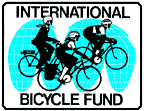First Aid for Bicyclists

![]() IBF is 100%
IBF is 100%
solar powered
![]()
Basic First Aid For Bicycle Travel: In An Emergency
Size Up The Scene. Evaluate The Situation. Don’t endanger yourself (move among down power line or enter a burning building) to aid someone. If the scene is safe approach the victim.
Perform and Initial Assessment. Determine if the victim is conscious (shake and shout). If not, use Personal Protective Equipment (PPE) (latex gloves and a CPR mask) to prevent disease transmission and check for ABC (Airway, Breathing and Circulation (pulse). If there is a problem with ABC begin appropriate treatment (rescue breathing or CPR). Don’t stop until EMS takes over or you are exhausted. Check for severe bleeding.
Summons EMS. Have an assistant summons EMS if the victim is; unconscious, has any problems with ABC, has severe bleeding, you suspect a head, neck or back injury, has a severe burns, allergic reaction, head ache, stroke, seizures, vomiting blood, passing blood, broken bones. or suspected poisoning. If EMS are not available begin arranging for other more highly trained and equipped medical assistance.
Obtain Consent. If the victim is conscious ask for consent. (See “Consent”, “Implied Consent”, and “Refusal of Care” above.)
Perform a Secondary Assessment. The secondary assessment is
performed if there are no life-threatening conditions (ABC). It is a
systematic, head-to-toe for adults and toe-to-head for children, method for
gathering information about medical history, injuries or conditions that may
need care
Use the mnemonic SAMPLE to remember the question for taking a brief
history:
S – Signs and symptoms. Where do you have pain, discomfort, numbness, ect.?Perform a Head-to-Toe (for adults) or Toe-to-Head (for children) examination.
A – Allergies. If so, what kind of reactions.
M – Medications. What medication for what conditions? Are they being taken as prescribed?
P – Pertinent past medical history. Any recent falls, accidents or blows? Past medical, surgical or trauma incidents?
L – Last oral intact of food or liquid. When and what?
E – Events leading up to the incident. Details on activities leading up to and during the incident.
Head. Look at the scalp, face, ears, eyes, nose, lips and mouth for cuts, bumps, bruises and depressions. Feel the forehead with the back of your hand. Note changes in the level of consciousness or alertness.After completing the check, care for any conditions found. Have the patient rest in a comfortable position. Continue to watch for changes in consciousness and breathing. If any life-threatening conditions develop, at any time, provide appropriate care immediately.
Skin. Is it moist or dry; or red, pale, flushed or ashen?
Neck. If no injury to the neck is suspected, ask the patient to move their head from side-to-side.
Shoulders. Ask the patient to shrug their shoulders.
Chest and Abdomen. Ask the patient to take a deep breath and blow air out. Listen.
Arms. Check on arm and then the other. Ask the patient to move their hands and fingers and bend the arm.
Legs. Check on leg and then the other. Ask the patient to move their foot and toes and bend the leg.
Notify the Chain of Command. Depending upon the context and seriousness of the incident you may need to notify superiors or officials.
Interview Witnesses. Depending upon the context and seriousness of the incident you may need to interview and record information from witnesses.
Complete Reports. Depending upon the context and seriousness of the incident you may need to submit some form of written information.
Check Supplies and Equipment. If you used supplies and/or equipment, make sure used items are replaced and equipment is clean and ready for future use.
Debrief. Review all the characteristics of the incident and if possible correct any policies, procedures or situations that will help to reduce future incidents.
Basic First Aid for Bicycle Traveler and Tours
Return to Education: Bicycle Safety and Health Index.
Home | About Us | Contact Us | Contributions | Economics | Education | Encouragement | Engineering | Environment | Bibliography | Essay Contest | Ibike Tours | Library | Links | Site Map | Search
![]()
The International Bicycle Fund is an independent, non-profit organization. Its primary purpose is to promote bicycle transportation. Most IBF projects and activities fall into one of four categories: planning and engineering, safety education, economic development assistance and promoting international understanding. IBF's objective is to create a sustainable, people-friendly environment by creating opportunities of the highest practicable quality for bicycle transportation. IBF is funded by private donation. Contributions are always welcome and are U.S. tax-deductible to the extent allowed by law.
![]()
![]() Please write if you have questions, comment, criticism, praise or
additional information for us, to report bad links, or if you would like to be
added to IBF's mailing list. (Also let us know how you found this site.)
Please write if you have questions, comment, criticism, praise or
additional information for us, to report bad links, or if you would like to be
added to IBF's mailing list. (Also let us know how you found this site.)
